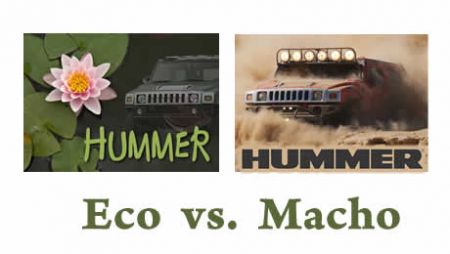HUMMER: Split-Brain Branding

The last few weeks have had plenty of news about the Hummer brand. The biggest news, of course, is that General Motors announced that they were putting the Hummer line up for review and possible divestment. Just a day or so earlier, Hummer continued its history-making off road run when Team Hummer and Rod Hall Racing scored twin stock class victories in the Baja 500.
This dichotomy is typical for Hummer. At the same time that the trucks themselves are demonstrating their authenticity by winning most of the off road races they enter, GM is dithering about what to do with the brand. GM is right to be concerned, of course – high fuel prices are putting pressure on truck sales across the board. But even before the last jump in gas prices, they couldn’t quite seem to figure out how to best market Hummers.
Despite GM’s current ambivalence, the ascent of the Hummer brand has been remarkable. GM took over the brand a mere decade ago from AM General, and both the HUMMER brand and the iconic shape of the vehicle have become instantly recognizable. I was surprised that Hummer didn’t make Millward Brown’s Top 100 Most Powerful Brands list, but with decades-old brands like Motorola and Volkswagen just hitting the 90s, perhaps it’s not so odd. There’s a dichotomy in the brand recognition, too. While for many the Hummer brand represents ruggedness, durability, and “can-do” capability, for others it’s a symbol of gas-guzzling excess. Whichever side you are on, though, it’s hard to argue with the visibility and recognition of the Hummer brand.
The split-brain thinking carries over to GM’s advertising for Hummers. GM’s recent ad is a good example. (The YouTube link for that ad no longer works – if you find the video, which was full of calm forest scenery, please let us know!)
What’s the primary image one gets from that ad? I remember wildflowers. Do people really choose a Hummer because they can’t reach their favorite woodland flora in other vehicles? There’s an implied stream crossing, but the images seem to be deliberately vague; I suppose a Hummer charging through a creek with water flying in all directions would destroy the tranquil mood. The image below isn’t an actual GM ad (at least not yet!) but I think it conveys the idea of where GM is headed:

I’ve got news for Hummer advertising execs: environment crusaders aren’t going to buy a Hummer, even one pictured in a sylvan utopia. Car buyers concerned about fuel economy aren’t going to buy a truck with the aerodynamics (and approximate size) of a condominium. Hummer needs to stop trying to satisfy every constituency in the market, and build on its strengths.
What are those strengths? In both reality and perception, the Hummer is exceptionally rugged and capable. The H2 in particular is a unique product: massive in size, it can do things and go places that no other production truck can. The phenomenal off road performance of Team Hummer, using mostly stock suspension components, is a good starting point. Every race has the potential to produce amazing footage of Hummer trucks getting airborne, bouncing over boulders, getting sideways in deep sand, and so on. For those who find racing a bit too distant from real life, there are plenty of other unique successes to promote. Hummers are being used in rescue operations around the country in support of the Red Cross – how about some serious footage of volunteer Hummer owners in action? Or professional Hummer users like police or fire departments?
In the “Eco vs. Macho” contest, “Macho” is clearly the strategy that will sell more trucks. HUMMER’s unique brand proposition is that it is the toughest and most capable off-road production vehicle, and its marketing must not let buyers forget that.

Buying a luxury vehicle has very little to do with practicality and daily use. How many buyers of a $70,000 sports car drive it in competition, or even push it to its maximum speed or cornering ability? Very few… but they know they COULD, given the opportunity. And they like other people to know that they could, too. Similarly, few Hummer owners will climb mountains, cross the desert, or rescue flood victims. But, they know they could do all these things, and a lot more, if they had the chance.
My brief advice to Hummer marketers: build on your strengths. Accept the fact that Hummer will be a boutique brand. Emphasize the luxury end of the spectrum instead of trying to come up with low-end models for the masses. Keep demonstrating how rugged, capable, and otherwise macho Hummers are. A trip through the woods shouldn’t be tranquil flowers and gently bubbling brooks – think more along the lines of a roaring engine and dirt flung from knobby tires churning down a narrow logging trail at high speed. In general, use “fantasy” scenarios that show real trucks doing real things. Rod Hall airborne in the Baja, and crossing the finish line dusty but victorious. Hummer Club volunteers rescuing kids from dangerous high water. Find a mountain climbable in a Hummer and be the first truck to reach the summit. The tagline could be something along the lines of, “Real Trucks. Real Action.” (I think the current “Like Nothing Else” tagline is actually quite expressive – if the rest of the marketing lived up to that promise, it would work unaltered.)
Even the Hummer’s thirst for fuel might be a perverse status symbol for well-heeled buyers. Tooling around town in a highly customized H2 demonstrates that the buyer is affluent enough not only to buy a costly truck, but to handle a three-digit fill-up.
My strategy presents a dilemma, though, for a company trying to convince the world that it is both environmentally sensitive and committed to fuel conservation, and is a generally likable corporate citizen. The Hummer brand is already a lightning rod for GM critics, no doubt one reason why GM has taken a rather wimpy tone in its ads. Another problem is that Hummer is never going to be a huge part of GM, and Detroit seems to have difficulty making money on low-volume brands.
The best approach for GM may be to deal the Hummer brand to a firm willing to sell Hummers as a lower volume, boutique brand of truck. India’s Tata just picked up Jaguar and Land Rover from Ford. It’s intriguing to imagine Land Rover and Hummer, two truly authentic makers of serious off-road vehicles, being under the same roof. Others speculate that a Chinese auto firm might buy Hummer. Hummer might be one of the best acquisition values in the automotive market in terms of brand recognition and image. It’s unfortunate that GM, by making the announcement that they were reviewing the status of Hummer, have already tarnished the luster of the brand a bit. GM needs to both sharpen its current Hummer marketing and make a decision on the future of the division – if GM fails to act quickly and decisively, they could squander the amazing progress they have made in building the Hummer brand.
